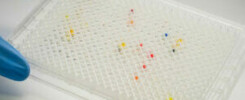“Thanks to a technology based on mass spectrometry, we were able, in less than 10 months, to demonstrate in vitro the accumulation of ceramides in the fibroblasts of Calixte, and to test the effect of more than 2000 active ingredients of drugs. Analysis of benefit-risk ratios enabled to select three drug candidates.”
Although medical advances are constant, our societies still face diseases for which no cure exists. This is particularly the case with rare monogenic diseases, which number in the thousands and affect hundreds of millions of people around the world.
12-year-old Calixte is one of them. She has an ASAH1 enzyme deficiency. This enzyme breaks down certain types of lipids: ceramides. Unfortunately, when this enzyme does not work properly, the cells accumulate these ceramides which disrupt their functioning, and particularly impact the neuronal cells controlling movement, the motor neurons.
The ASAP-4-children association, founded by Calixte’s parents, approached Apteeus at the end of 2019. We have adapted our technology to Calixte’s disease to identify therapeutic avenues through the “repositioning of drugs”. Calixte donated some of his fibroblasts via a skin biopsy. It is on these cells that we conducted a personalized research program.
A little over a year after the first experiences, Calixte was prescribed a personalized treatment based on the results produced by Apteeus. Since then, the whole team has remained mobilized. We have thus set up a technique for dosing circulating ceramides allowing monitoring of the efficacy of the treatments used in addition to clinical monitoring, and today continue to support the ASAP-4-children association and doctors in the evaluation of the advisability of using these treatments for other patients with ceramidase deficiency as Satine and Adeline.


